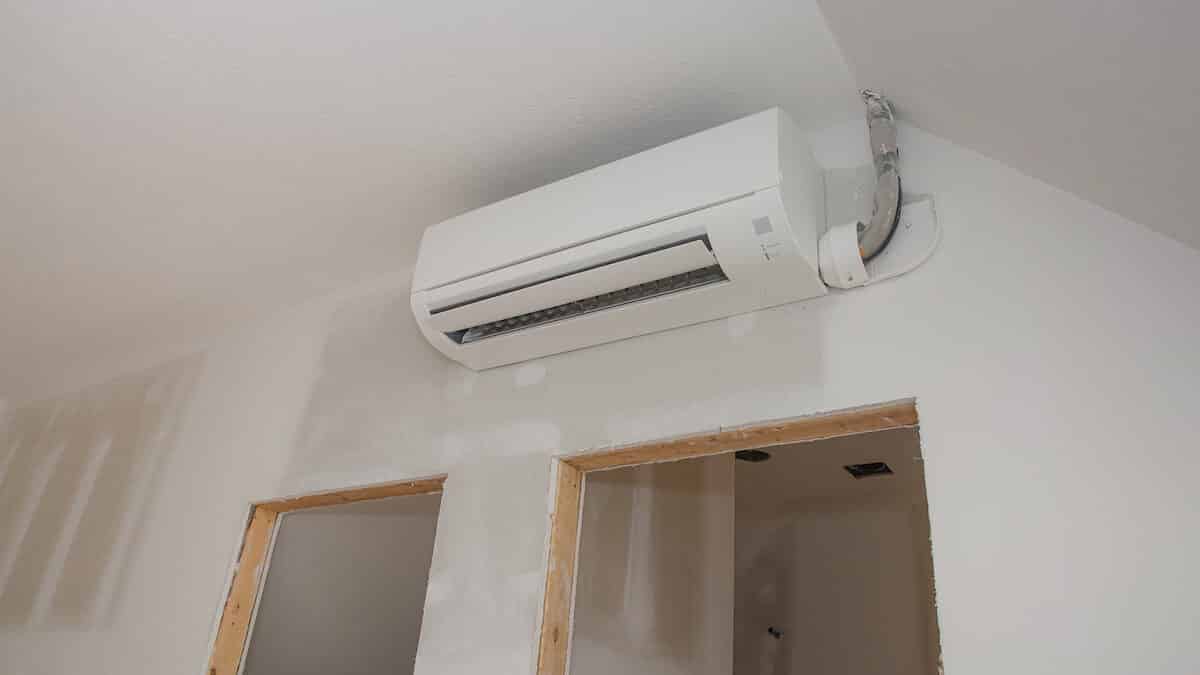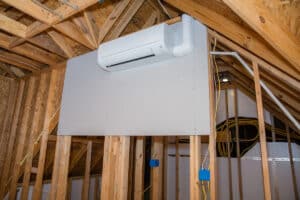Is a Mini-Split AC System Right for You?

Choosing the right air conditioning (AC) system for your home or business is essential to ensure optimal comfort and energy efficiency. One option that has gained popularity in recent years is the mini-split AC system.
In this article, we will explore:
- What mini-split AC systems are
- Their advantages
- Considerations for choosing one
- Scenarios where they excel
- Their limitations
- Alternative options
By the end, you will have a better understanding of whether a mini-split AC system is the right choice for your cooling needs.
What is a Mini-Split AC System?
Mini-split AC systems, also known as ductless AC systems, consist of an outdoor unit, one or more indoor units, refrigerant lines, and controls.
Unlike traditional central AC systems that rely on ductwork to distribute conditioned air, mini-split systems use individual indoor units to cool specific zones or rooms. Each indoor unit is connected to the outdoor unit by refrigerant lines, allowing for independent temperature control.

Advantages of a Mini-Split AC System
There are several advantages to choosing a mini-split AC system for your cooling needs.
Flexibility in installation and design
One of the main benefits of mini-split systems is their flexibility in installation. Since they don’t require ductwork, they can be installed in homes or buildings that lack existing ducts. This makes them ideal for older homes or structures where retrofitting ductwork may be challenging or expensive.
Additionally, mini-split systems offer design flexibility as indoor units can be mounted on walls, ceilings, or even recessed into the ceiling, blending seamlessly with the decor.
Energy efficiency and cost savings
Mini-split AC systems are known for their energy efficiency. With traditional central AC systems, cooled air can be lost through leaky ducts, reducing efficiency. Mini-split systems eliminate this issue by delivering cooled air directly to the desired areas.
Moreover, the ability to control each indoor unit independently allows for zoned cooling, which means you can cool specific areas while leaving others unconditioned. This level of control leads to energy savings and reduced utility bills.
Zoning capabilities for personalized comfort
The zoning capabilities of mini-split AC systems are a significant advantage. By installing multiple indoor units, you can create different zones and customize the temperature in each area according to individual preferences.
For example, you can keep the living room cooler during the day while maintaining slightly higher temperatures in unused bedrooms. This zoning feature not only enhances comfort but also saves energy by avoiding unnecessary cooling of unoccupied spaces.
Quieter operation
Traditional AC systems often produce noticeable noise, especially if the air handler is located within the living space.
In contrast, mini-split systems tend to be quieter since the noisier components, such as the compressor, are placed outside. The indoor units produce minimal noise, allowing for a peaceful and comfortable indoor environment.
Improved indoor air quality
Indoor air quality is a crucial consideration for any AC system. Mini-split systems typically include advanced filters that help capture dust, pollen, allergens, and other particles, improving the overall air quality.
Furthermore, the absence of ductwork reduces the risk of contaminants accumulating and circulating through the system.
Considerations for Choosing a Mini-Split AC System
While mini-split AC systems offer many benefits, it’s important to consider several factors before making a decision.
Sizing and capacity
Properly sizing the mini-split system is essential for efficient and effective cooling. Factors such as room size, insulation, climate conditions, and the number of occupants need to be taken into account.
An undersized system may struggle to cool the space adequately, while an oversized system can lead to frequent on-off cycles and reduced efficiency. Consulting with an HVAC professional can help determine the appropriate system size and capacity for your specific needs.
Installation requirements
Before opting for a mini-split AC system, it’s crucial to assess the feasibility of installation in your space. While mini-split systems are generally more flexible than traditional AC systems, they still require proper placement of the outdoor unit and sufficient space for the indoor units.
Additionally, determining the number of indoor units required to adequately cool your space is essential. Factors such as room size, layout, and cooling demands should be considered to ensure proper coverage.
Cost considerations
While mini-split systems offer long-term energy savings, the initial purchase and installation costs can be higher compared to other AC options.
The cost of a mini-split system depends on factors such as the number of indoor units, capacity, brand, and additional features.
It’s essential to weigh the upfront investment against the potential long-term energy savings to determine the overall cost-effectiveness of a mini-split system for your specific situation.
Maintenance and servicing
Like any AC system, mini-split systems require routine maintenance to ensure optimal performance and longevity. Necessary maintenance tasks include:
- Regularly cleaning or replacing filters
- Checking refrigerant levels
- Inspecting the system for any issues
Before purchasing a system like this, you need to ensure there is a local service and support provider in your area. Having access to qualified technicians who can provide maintenance and servicing when needed is crucial for the smooth operation of your AC system. If you live in Gwinnett and Walton Counties in Northeast Georgia, Trust Heating and Air can service you!
Situations Where a Mini-Split AC System Would Excel
Mini-split AC systems are particularly well-suited for certain scenarios:
1. Older homes or buildings lacking ductwork
If you reside in an older home or building without existing ductwork, installing traditional central AC can be expensive and disruptive. Mini-split systems provide an excellent alternative, as they can be installed with minimal disruption and offer efficient cooling for individual rooms or zones without the need for ducts.
2. Home additions or renovations, like sunrooms or rooms above a garage
When adding new rooms or renovating existing spaces in your home, extending the ductwork for central AC may not be practical. Mini-split systems are a convenient solution in such cases, allowing you to cool the new or renovated areas independently of the rest of the house.
3. Small apartments or individual rooms
For smaller living spaces, such as apartments or individual rooms, a mini-split AC system can provide efficient cooling without the need for a centralized system. The flexibility in installation and zoning capabilities make mini-split systems an ideal choice for personalized comfort in these settings.
4. Commercial spaces with specific cooling requirements
Commercial spaces, such as offices, retail stores, or server rooms, often have specific cooling requirements. Mini-split AC systems can be an excellent option for providing targeted cooling to these areas without the need for extensive ductwork or significant modifications to the existing HVAC system.

Limitations and Alternatives of a Mini-Split AC System
While mini-split AC systems offer numerous advantages, they may not be suitable for every situation. It’s important to consider their limitations and explore alternative options.
Inability to provide central cooling for large areas
If you have a large property or require centralized cooling throughout the entire building, a mini-split system may not be the most efficient solution. In such cases, traditional central AC systems with ductwork might be a better choice to ensure consistent cooling in all areas.
Compatibility with existing HVAC systems
If you already have a centralized HVAC system in place, it’s worth considering whether integrating a mini-split system would complement or conflict with your existing setup. Consulting with an HVAC professional can help you evaluate compatibility and determine the most suitable solution.
Alternative options, such as central AC or window units
While mini-split AC systems provide flexibility and energy efficiency, alternative options like central AC systems or window units may be more suitable for certain situations. Central AC systems are ideal for whole-house cooling, while window units can be cost-effective for cooling individual rooms if the installation of a mini-split system is not feasible or practical.
Plan to Install a Mini-Split AC System?
Deciding whether a mini-split AC system is right for you requires careful consideration of various factors. The flexibility in installation, energy efficiency, zoning capabilities, quiet operation, and improved indoor air quality make mini-split systems an attractive option for many homeowners and businesses.
However, it’s crucial to assess sizing and capacity requirements, installation feasibility, cost considerations, and maintenance needs before making a decision.
Mini-split AC systems excel in scenarios where ductwork is lacking, such as in older homes or buildings, as well as in home additions or renovations. They are also suitable for cooling small apartments or individual rooms and catering to specific cooling needs in commercial spaces.
However, they may not be the best choice for central cooling in large areas or when compatibility with an existing HVAC system is a concern.
Ultimately, consulting with an HVAC professional is highly recommended to assess your specific needs and determine the most suitable cooling solution. They can provide expert advice, evaluate your space, and help you make an informed decision based on your requirements, budget, and long-term goals.
In conclusion, mini-split AC systems offer unique advantages and are worth considering for their:
- Flexibility
- Energy efficiency
- Zoning capabilities
- Quiet operation
- Improved indoor air quality
By carefully evaluating the factors discussed in this article and seeking professional guidance, you can determine whether a mini-split AC system is the right choice to keep you cool and comfortable in your home or business.
If you need help deciding if a mini-split AC system is right for you, contact the team at Trust Heating and Air! We’d love to help you make the right AC system choice for your home or space!



